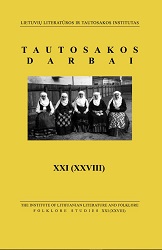VILNIAUS APYLINKIŲ PADAVIMAI
THE LOCAL LEGENDS OF THE VILNIUS REGION
Author(s): Beata Piasecka, Ida Stankevičiūtė, Vykintas VaitkevičiusSubject(s): Cultural history, Customs / Folklore, Human Geography, Regional Geography, Oral history
Published by: Lietuvių literatūros ir tautosakos institutas
Keywords: Vilnius region; Local legends; folk stories; folk belief;
Summary/Abstract: The publication comprises folklore material, recorded in the Vilnius region during the 2003–2004 on the initiative of the Neris regional park. The material consists of 90 local legends and folk stories altogether, recorded in Polish (78 items) and Lithuanian (12 items), and related to the 53 localities in Vilnius and its region (fig. 1), primarily to the mountains, boulders, streams and trees. Of these, as many as 25 texts describe the waterholes, shals and separate stones lying in Neris (Vilija) river. The majority of the informants consider themselves Poles and speak in specific dialect of the Polish language. Some of them have spent their entire lives in the same place. Thus it is natural for them to remember various local legends. Motives depicting the wedding parties (texts Nos. 19–20, 77–88) and brothers (Nos. 21–24, 43, 44, 54) turned into stones deserve special attention. As many as five groups of such stones can be found lying in the watercourse of the Neris river. The folk belief in the magical qualities of the streams running ”agianst the sun” (usually eastwards) also boasts extreme popularity in this region (Nos. 32, 33, 40, 41, 57, 73, 90). Besides, an interesting legend tells of the Ilgoja stream being sweet, because a man snatching honey from a bear has inadvertently spilled it into the water (Nos. 51, 52). A local legend telling of the introducing Christianity in this region supplies interesting evidence regarding history of the first Lithuanian capital, Kernavė (Nos. 61, 62). Generally, the published texts are valuable in terms of language, folklore, ethnology and history studies. They enable us filling up at least some of the vacancies in our comparatively scant knowledge of the Vilnius region’s history and culture.
Journal: Tautosakos darbai
- Issue Year: 2005
- Issue No: 29
- Page Range: 219-261
- Page Count: 43
- Language: Polish, Lithuanian

